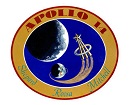Stafford: Hello, Houston; Apollo.
Bobko: Apollo, Houston. Go ahead.
Slayton: All right, Bo. We got a problem. We can't get the probe out to stick that wonderful little freezer up there.
Bobko: Understand. You can't get the probe out.
Stafford: Yeah, Vance will tell you about it. Here - -
Brand: Okay, Bo. Everything in the probe removal checklist on the cue card is going - has been going great up through step 11. Step 12 is "Capture latch release, tool 7." You insert it in the pyro cover. You turn it a 180 degrees clockwise to release the capture latches. Well, here's where the problem is, and let me explain it to you. If - do you have somebody there that knows the probe that can listen?
Bobko: Roger; understand.
Brand: Now I suppose that one thing I could do is take the cover off - the pyro cover off - and I've got proper tools to do that.
Stafford: Bo, what it's coming down to is a decision we ought to make pretty soon. We've been up pretty late and this whole thing about sticking the cryo freezer up there came about because of the ventings. And either we're going to stay up another 3 or 4 hours wrestling that probe or else we're going to call it quits.
Bobko: Roger. We copy and we're talking about it right here now.
Brand: Incidentally, I stuck a pencil down in - or a pen down in there to see if I could easily move that pyro connector out of the way, and it doesn't seem to want to move.


